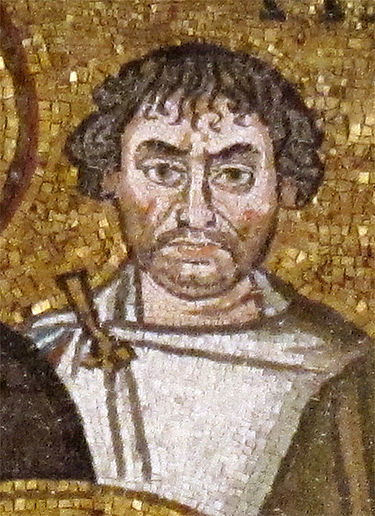
Man traditionally identified as Narses, from the mosaic depicting Justinian and his entourage in the Basilica of San Vitale, Ravenna
Narses was a eunuch of Armenian origin who became one of the most able and loyal members of Justinian’s militia. Though Roman law prohibited the castration of males, there was nevertheless a demand for eunuch slaves, particularly in the imperial court, and Armenia, partitioned between the Byzantine Empire and Persia, with Persia controlling by far the greater share, was one of the regions beyond the imperial boundaries that supplied the demand for eunuchs. Nothing is known of Narses’ youth, but at the time of the Nika riot in 532, he was a koubikoularios and a spatharios. The koubikoularioi were palace eunuchs who were in attendance on the emperor or empress, and the spatharioi were a corps of the koubikoularioi who served as bodyguards. Narses was an invaluable ally of Justinian during the Nika riot, for he attempted to sow dissension in the ranks of the mob by bribing rioters who seemed approachable to support the regime. But in the end it was the strong-arm tactics of Belsarius and Moundos that suppressed the uprising.
Narses was a favorite of Empress Theodora, partly, perhaps, because his religious sympathies were with the anti-Chalcedonians, though publicly he maintained a diplomatic neutrality. In the summer of 535, Theodora sent him to Alexandria at the head of a corps of 6,000 troops to support Theodosios, the newly elected patriarch of Alexandria. Theodosios was a moderate Monophysite, a disciple of Severos, the patriarch of Antioch who had been exiled by Emperor Justin I. On the death of Patriarch Timothy III of Alexandria, Theodosios was chosen to succeed him, but as he was being consecrated (February 535), the cathedral was invaded by a mob that supported a rival, Gaianos, a Monophysite extremist whose doctrine, known as Aphthartodocetism, taught that Christ’s human body was incorruptible from the moment of birth. Theodosios barely escaped with his life, and once Narses arrived, civil war broke out in the streets of Alexandria. Narses maintained Theodosios on the patriarchal throne for 103 days, after which he admitted defeat and returned with Theodosios to Constantinople.
Narses’ next mission was to Italy, to reinforce Belsarius, but the two generals quarreled, and their failure to cooperate led to the fall of Milan to the Goths in 539. The adult males were slaughtered and the women given as slaves to the Burgundians. Justinian assigned fault for the catastrophe to neither general, but he recalled Narses. In 541, Narses helped Theodora and Antonina in their plot to bring about the fall of the praetorian prefect, John the Cappadocian. He then contemplated retiring to a monastery, and in fact, he built a monastery known as Rupis, along with a church and lodgings for pilgrims, in Bithynia in northwest Asia Minor, and gave it a generous endowment. But in 551, Justinian chose Narses to take command of the war in Italy, which had reached desperate straits after Belsarius’ recall. Belsarius had been starved for troops, and Narses told the emperor frankly that nothing could be achieved unless he devoted more resources to the war against the Ostrogoths. Justinian listened. Narses got the necessary resources, and in midsummer of 552, he defeated the Goths at Busta Gallorum. Narses’ tactics were masterly, but he also commanded an army that outnumbered the Goths.
The Goths chose Teias to replace Totila, who died of his wounds after the battle of Busta Gallorum. The last struggle between the Goths and the Byzantines took place in southern Italy, at the foot of Monte Lattari near Naples. Narses then remained in Italy as its effective ruler until Justinian’s successor, Justin II, dismissed him from office. The reason seems to have been a flood of complaints from the Romans to Justin II and his wife, Sophia, that Narses was enriching himself at their expense and was acting as a tyrant. Sophia in particular disliked him, and her enmity made Narses hesitate to return to Constantinople. He remained in Rome and watched from the sidelines when the Lombards invaded Italy in 568, and met only ineffective and disorganized resistance. He died in Rome, aged ninety-five, in 574, and his body was taken to Constantinople in a lead coffin, and then was buried in the monastery that he had founded.